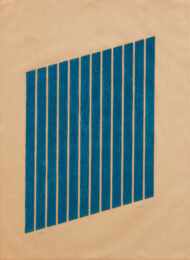


1928-1994
Donald Judd began exploring artistic expression through painting in the late 1940s in New York City. His first exhibition opened in 1957 and was a collection of abstract paintings. He had an unusual route into art, as he had been a philosophy student at college. His attention was turned towards creative pursuits as a result of his Masters’ degree in the History of Art.
Although many associated him with minimalism, it was a term Donald Judd always denied was representative of his art. He felt what he created went beyond minimalism, but it is nevertheless a movement that continues to be associated with his work. He called for a new specifically American artistic expression that turned away from the European artistic values of illusion and represented space, and towards real space. For his later pieces he moved away from painting worked instead as a sculptor, from the mid 60s onwards. He used a variety of unusual materials, including plywood and ten steel. Sculptors today still site his influence. A native of Excelsior Springs Missouri, Judd died in Manhattan, New York City, in 1994 at the age of 65. He was still working as an artist up until the time of his death.
Per the Judd Foundation:
Over the course of four decades, Donald Judd created hundreds of prints using aquatint, etching, and screenprint techniques though the woodcut was his primary print medium. As a printmaker, Judd investigated many of the same issues of form and color that are found in his paintings and three-dimensional works. Judd’s long-term work with prints as well as his large collection of works by master printmakers attest to his belief that printmaking is as serious an art form as painting or sculpture.
Judd studied printing techniques while at the Art Students League, and designed his first prints starting in 1951. Working first with lithographs, Judd shifted his attention to woodcuts, which became his dominant print medium as early as 1953. Throughout the 1950s, Judd’s woodcuts develop an angular and robust style. Moving away from figuration, Judd used line, first curved and then straight, repetition, shape, and color. Judd also explored screenprint techniques, sometimes using different techniques to generate the same shape, such as in the case of the parallelogram, which he used in his sculpture as well as in woodcuts, etchings, and aquatints.
Both Judd’s late paintings from the early 1960s, and his early prints from the same time period demonstrate an interest in lines and intervals and even share identical shapes. In 1963, Judd’s father, Roy C. Judd, created the woodblocks for what became Judd’s first large-scale series of prints.